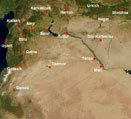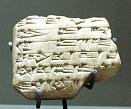 |
| in Syria |
|
Español | عربي |
Introduction: Mari (Where History Began Before History) was an ancient city in Syria situated on the site of Tell Hariri, 11 kilometers north-west of the modern locality of Abu Kamal on the western bank of Euphrates river, some 120 km southeast of Deir ez-Zor, Syria. It is thought to have been inhabited since the 5th millennium BC, although it flourished from 2900 BC until 1759 BC, when it was sacked by Hammurabi. Abraham is thought to have passed through Mari on his way from Ur to Harran. Mari was discovered in 1933 on the eastern of Syria, near the Iraqi border. A Bedouin tribe was digging through a mound for a gravestone that would be used for a recently deceased tribesman, when they came across a headless statue. After the news reached the French authorities currently in control of Syria, the report was investigated and digging on the site was started on December 14, 1933 by archaeologists from the Louvre in Paris. Discoveries came quickly, with the temple of Ishtar being discovered in the next month. Mari was classified by the archaeologists as the "most westerly outpost of Sumerian culture". Since the beginning of excavations, over 25,000 clay tablets in Akkadian language written in cuneiform were discovered. Mari has been excavated every year since 1933 (except for the period 1939-1951). Less than half of the 1000 by 600 meter area of Mari has been uncovered as of 2005. Although archaeologists have tried to determine how many layers the site descends, it hasn't proved possible. According to French archaeologist André Parrot, "each time a vertical probe was commenced in order to trace the site's history down to virgin soil, such important discoveries were made that horizontal digging had to be resumed". Ancient History  Mari had been inhabited since the 5th millennium BC, but the real significance of the city was during the third and second millennia BC. The inhabitants of Mari were a Semitic people, thought to be part of the same Eblaite and Akkadian migration. First Golden Age The city flourished since it was strategically important as a relay point between Sumerian cities of lower Mesopotamia and the cities of northern Syria. Sumer required building materials such as timber and stone from northern Syria, and these materials had to go through Mari to get to Sumer. First Destruction After a period of eminence beginning 2900 BC, Mari was destroyed around 24th century BC. This destruction brought a period of relative decline in importance in the region and the city was reduced to no more than a small village. Historians are divided when it comes to who destroyed the city; some name Sargon of Akkad (who stated that he had passed through Mari on his famous campaign to the west), while others say it was the Eblaites, Mari's traditional commercial rivals. Second Golden Age The status of the city was revived again under an Amorite dynasty. The second golden age commenced around 1900 BC. Two significant archaeological discoveries were made that dated back to this period. The palace of Zimri-Lim, a king of Mari (ca. 1775-1761 BCE), contained over 300 rooms. The palace was possibly the largest of its time, and its reputation in neighboring cities and kingdoms was well-known. Supposedly, "King Yahmad of Aleppo and the King of Ugarit both expressed their desire to visit the palace"[attribution needed] to see its splendor for themselves. The state archives were also built during this time. From the archives over 25,000 cuneiform tablets have been taken. The tablets, according to Andre Parrot, "brought about a complete revision of the historical dating of the ancient Near East and provided more than 500 new place names, enough to redraw or even draw up the geographical map of the ancient world". Final Destruction Mari was destroyed again around 1759 BC by Hammurabi. This is known from the numerous state archives tablets that recount Hammurabi turning on his old ally Zimrilim, and defeating him in battle. After this destruction, there were scattered inhabitations by Assyrians and Babylonians, but the city remained a village until the arrival of the Greeks, and vanished from history thereafter. Economy The growth of the city from a small village to an important trading center was due to its diverse economy in the ancient world. The city came to control the trade lanes between different regions such as western Iran, Mesopotamia, Carchemish, and parts of Anatolia. Cities that Mari is confirmed to have traded with include Ur, Aleppo, and Ugarit. The cargo brought through the city grew to include dates, olives, pottery, porcelain, grains, timber, and stone. Culture and religion  Intendant Ebih-Il, found in the temple of Ishtar at Mari, Archaic Dynasties (ca. 2400 BC), Louvre MuseumThe citizens of Mari were well known for elaborate hair styles and dress, and were considered to be part of Mesopotamian culture, despite being more than 150 miles upriver of Babylon. It is theorized by some that Mari functioned as a trading outpost for southern Mesopotamia. The inhabitants of Mari worshiped a vast array of Sumerians gods and goddesses. Dagan, the deity of storms, had an entire temple dedicated to him, as did Ishtar, the goddess of fertility, and Shamash, the Sun god. Shamash was believed to be all-knowing and all-seeing, and in many seals he is seen standing between two large doors. According to the legend of Gilgamesh, these doors are between Mount Mashu, and are the eastern doors to heaven. Through Mari's extensive trade network, Sumerian gods and goddesses were taken to non-Sumerian cities such as Ebla and Ugarit and incorporated into their native religions. |
|||||||||||||||||||||||||||||||||||||||||||||||||||||
|
|
||||||||||||||||||||||||||||||||||||||||||||||||||||
|
|
|
|

Custom Search
|
| © Copyright Homsonline.com |
| |
||
| |
|
|

